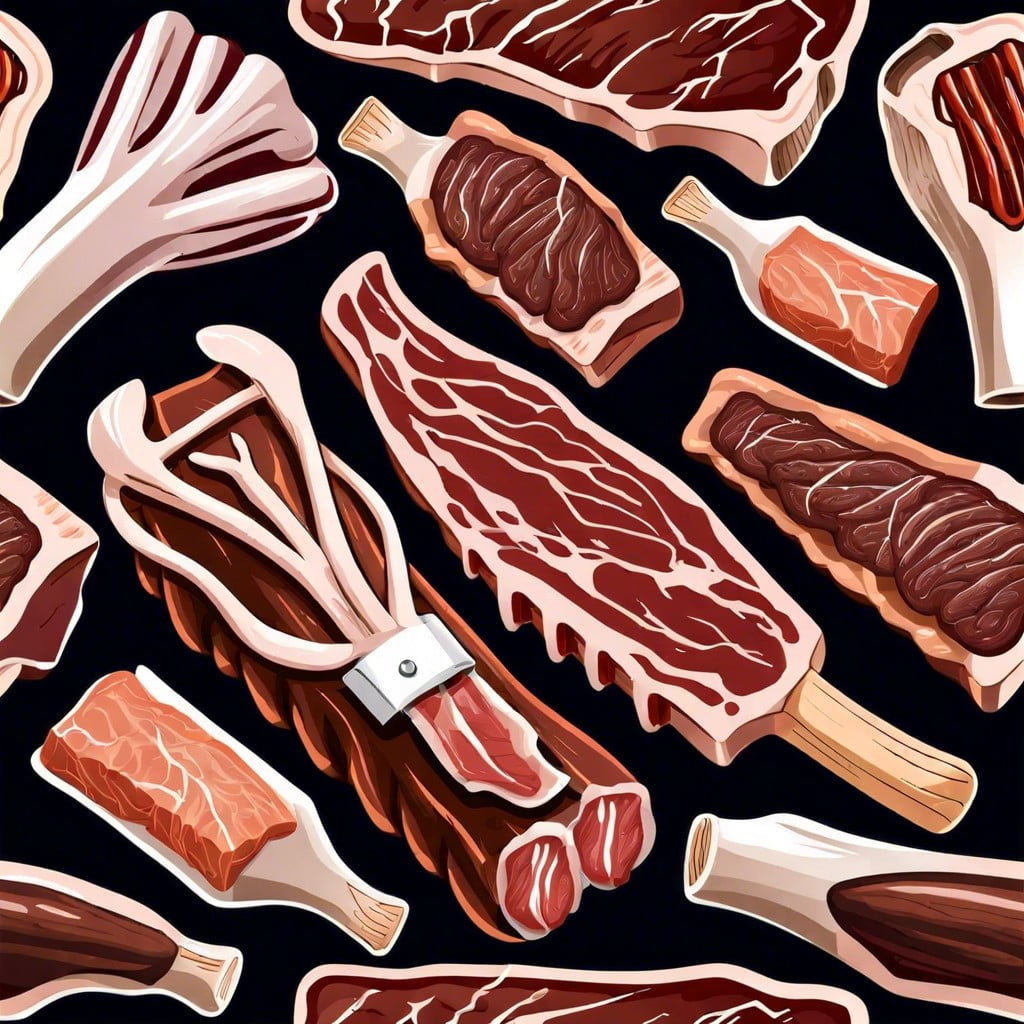Unlock the secrets to perfectly smoked BBQ beef ribs with this comprehensive guide to preparation, cooking techniques, and flavor enhancements.
Key takeaways:
- Choose beef ribs with marbling and evenly spaced bones
- Remove membrane, trim fat, and let ribs reach room temperature
- Create a balanced rub to enhance natural beef flavor
- Smoke ribs low and slow, using hardwoods for robust flavor
- Test for doneness with internal temperature or toothpick test
Choosing the Right Beef Ribs

Selecting cuts of beef ribs can seem daunting, but a few simple tips can guide your choice. Back ribs, hailing from the cow’s rib section near the spine, offer a satisfying balance between meat and fat, making them a popular choice.
For a meatier option, look for short ribs, which come from the lower portion of the rib cage. The slab should exhibit marbling throughout, as this fat renders during cooking, contributing to the ribs’ succulence and flavor. Opt for ribs with a thick coating of meat atop the bone.
Bones that are straight and evenly spaced allow for more uniform cooking. Thickness matters, too; excessively thin ribs can overcook easily, whereas too thick may require extended cooking times. Avoid “shiners,” where the meat has been cut too close to the bone, as they offer less value.
Always seek ribs that have a rich color and a fresh, not sour or off, smell. If packaged, ensure there’s no excess liquid, a sign of potential quality loss. Selecting ribs with these characteristics sets the foundation for an exceptional BBQ experience.
Preparing Beef Ribs for BBQ
Before igniting the grill, ensure your beef ribs are prepped for optimal flavor and texture. Start by removing the membrane on the bone side with a paper towel for grip—this promotes better smoke penetration and a tender bite. Trim excess fat to a thin layer, which safeguards moisture while preventing flare-ups. Give ribs time to reach room temperature for even cooking. Now they’re primed for a rub-down with your chosen spices, creating that mouth-watering crust barbecue aficionados prize. Patience here pays dividends when these ribs hit the heat.
Crafting the Perfect BBQ Rub
Balance is key when blending a rub that complements the rich flavor of beef without overpowering it. Start with a base of coarse salt and cracked black pepper to enhance the meat’s natural taste. Incorporate paprika for a hint of smokiness and a touch of color, and consider a minimal amount of brown sugar for a subtle sweet note that will caramelise beautifully during cooking. Garlic and onion powder add depth, while a hint of cayenne or chipotle powder can introduce a welcoming warmth without excessive heat. Toasted cumin seeds, ground and sifted into the mix, can introduce an earthy dimension that pairs exceptionally well with beef.
When applying the rub, do so liberally, ensuring that every crevice is covered. This creates a well-seasoned crust known as the “bark,” which is highly coveted among BBQ aficionados. The rub’s components will meld during the smoking process, creating a complex flavor profile that is simultaneously distinctive and cohesive. Remember, the rub is the first layer of flavor and should harmonize with the smoke and the natural taste of the beef, not compete with them.
BBQ Beef Ribs Smoking Techniques
Low and slow is the quintessential mantra for smoking beef ribs, aiming to tenderize the tough meat and imbue it with a deep smoky flavor. Opt for a temperature range between 225°F to 250°F, which allows the connective tissues in the ribs to break down without drying out the meat.
Hardwoods such as hickory, mesquite, or oak are ideal for beef due to their robust flavor profiles. Fruitwoods can be applied for a milder taste. It’s essential to balance smoke intake — too much can overpower the meat, creating bitter flavors.
The 3-2-1 method, which involves smoking for three hours unwrapped, two hours wrapped in foil (to retain moisture), and an additional hour unwrapped to finish, can be modified for beef ribs, which may require less time due to their varying sizes.
Throughout the smoking process, maintain a water pan in the smoker to keep the environment moist. This helps in temperature control and prevents the ribs from drying out.
Lastly, resist the urge to frequently open the smoker. Each peek releases heat and smoke, disrupting the cooking process. Trust the process, monitor the temperature, and adjust the vents as necessary to maintain the ideal smoking environment.
Testing for Doneness in Beef Ribs
Understanding when beef ribs have reached optimal doneness is crucial for yielding tender, succulent meat. Unlike other meats, beef ribs don’t adhere to the standard internal temperatures for doneness due to their high fat and collagen content, which require a low and slow cooking process to break down properly.
Utilize a reliable meat thermometer and aim for an internal temperature between 195°F to 205°F. At this range, collagen breaks down, transforming into silky gelatin, thereby tenderizing the meat.
Alternatively, implement the ‘toothpick test’ — probing the meat with a toothpick or a skewer. If it slides in and out with ease, similar to softened butter, the ribs are likely done.
Another tactile clue is the rib meat pulling back from the bone ends, typically revealing about a quarter inch of bone.
Finally, observe the bark. A well-formed crust with minimal resistance indicates a thorough cook, while ensuring flavors have penetrated and caramelized on the exterior.
While each method provides insight, using them in tandem can ensure a precise assessment of your beef ribs’ readiness.

